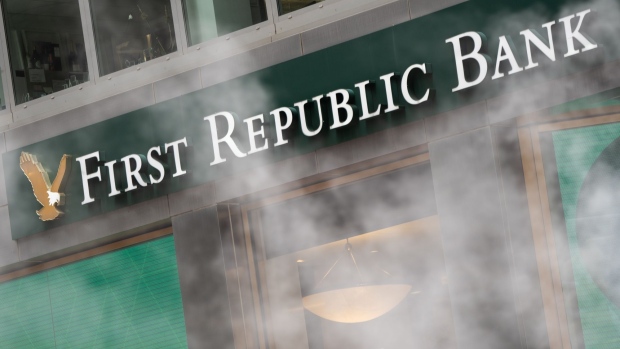Mar 13, 2023
US Regional Banks Remain Under Pressure as First Republic Sinks
, Bloomberg News

(Bloomberg) -- The turmoil that’s engulfed bank stocks deepened Monday as investors rushed to reduce exposure to the industry, triggering a cascade of trading halts as multiple lenders suffered record drops.
Regional banks were among the hardest hit as the KBW Regional Banking Index sank 7.7%, its sharpest plunge since June 2020. The rapid selloff came even as the Treasury Department, Federal Reserve and Federal Deposit Insurance Corp. said they were introducing a new backstop for banks that would be large enough to protect the entire nation’s deposits.
“Most banks are solvent under normal circumstances. The problem is, pretty much no bank can withstand a full bank run,” said Steve Sosnick, chief strategist at Interactive Brokers LLC. “The FDIC action removes the idea of a deposit bank run, but what we’re seeing is an investor bank run,” he added.
- First Republic Bank sank 62% for a record drop, sparking multiple halts for volatility
- Western Alliance Bancorp lost 47%, its biggest drop ever
- PacWest Bancorp dropped 21% to the lowest close since 2009
- Among other regional banks sinking more than 20% on Monday and triggering halts: Customers Bancorp Inc., Comerica Inc. and Zions Bancorp NA
Many large US banks also churned lower, with Bank of America Corp., Citigroup Inc. and Wells Fargo & Co. all slumping 5% or more on Monday.
Equity investors have so far found little reason to stick around to find out if the customer exodus putting some regional banks under existential pressure will ease. Treasury two-year yields sank as demand for haven assets soared.
“There will be a search for the next victim and the recession probability is set to increase over the next weeks,” said Alberto Tocchio, a portfolio manager at Kairos Partners.
The unwind is especially brutal because investors had piled into banks on the assumption they would benefit from the aggressive tightening by the Fed that sent interest rates to 4.5% from zero in just under a year. But while higher rates are often thought to buttress interest income, the issue is complicated in 2023 by a steeply inverted yield curve that depresses yields on longer-dated assets versus short-term liabilities.
While flows for several of the bank ETFs arrive with a delay, there were signs that investors had started to ditch holdings late last week. The $1.7 billion Invesco KBW Bank ETF (ticker KBWB) posted an outflow of $245 million in the latest data, the largest exit in a year.
Retaining deposits is hard when money market rates are as much as 50% higher than interest paid on savings accounts. And if deposits flee, banks may be forced to book what had only been paper losses on mortgage bond and Treasury holdings they are forced to sell.
“The market is likely to remain very cautious despite regulators stepping in,” said Marija Veitmane, senior multi-asset strategist at State Street Global Markets. “This is a difficult position Fed is in, on the one hand it needs to keep hiking to arrest inflation, but also it needs to protect the financial system. Feels like a lose-lose situation for the Fed and the market.”
The buckling shares highlighted that even after emergency measures by US regulators, including the new backstop for banks, investors remained on edge that more seizures were possible. The latest crisis poses a risk to the strong rally seen in US and European shares since October.
“After the liability-driven investment fund crisis in autumn 2022, we see this is another episode where parts of the financial system are hit by the unwinding of accommodative central bank policy,” said Deutsche Bank analyst Benjamin Goy.
While US regulators introduced a new backstop for banks that Fed officials said was big enough to protect the nation’s deposits, the surprise announcement that New York’s Signature Bank was being shuttered reminded investors that further turmoil, at least among regional banks, was still possible. A senior US Treasury official said some institutions had issues similar to the failed Silicon Valley Bank.
“We’re seeing a liquidity withdrawal, the classic thing that you’d expect following a credit event like what’s happening at SVB,” said Haig Bathgate at Atomos Investments. “People get scared, reduce exposure to equities and move into government bonds. They’re wondering if anyone else will be in this position as these things don’t tend to happen in isolation.”
US stocks tumbled at the end of last week when Silicon Valley Bank suddenly collapsed in the biggest such incident since the global financial crisis. The Fed’s aggressive tightening campaign has sent interest rates surging, leaving some banks holding long-dated bonds that have plunged in value at the same time their financing costs are surging.
“I don’t think the system as a whole is inherently financially unstable, certainly systemic risk has been considered low,” Susannah Streeter, Hargreaves Lansdown, head of money and markets, said in a Bloomberg TV interview. “But what I think you’re seeing is this risk averse nature really sweeping through and renewed worries just about higher interest rates being elevated for longer and the repercussions of that.”
--With assistance from Joe Easton, Maxwell Zeff and Ksenia Galouchko.
(Updates shares after third paragraph)
©2023 Bloomberg L.P.





